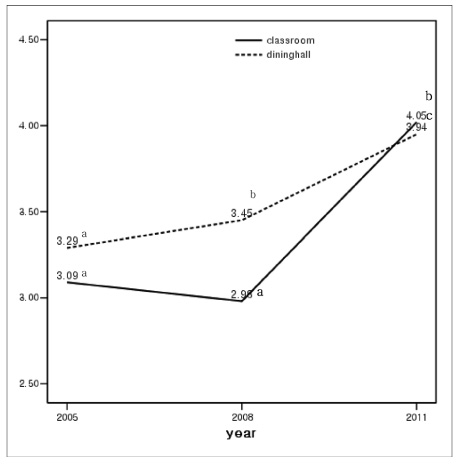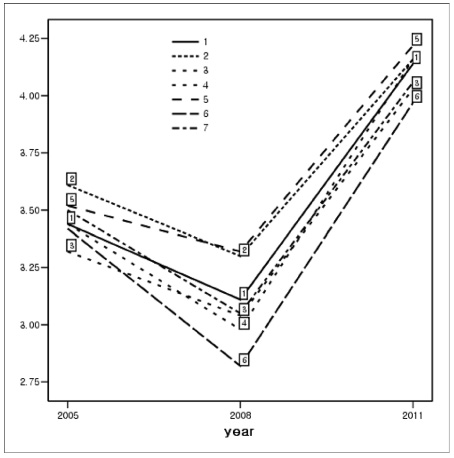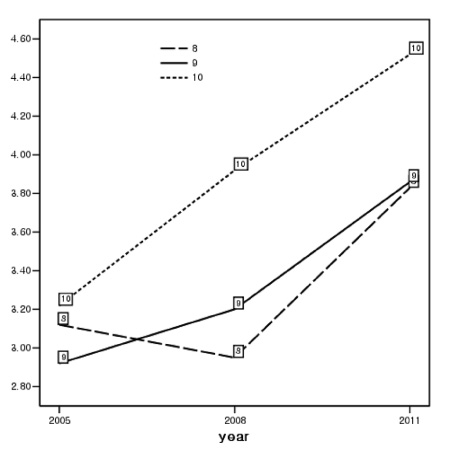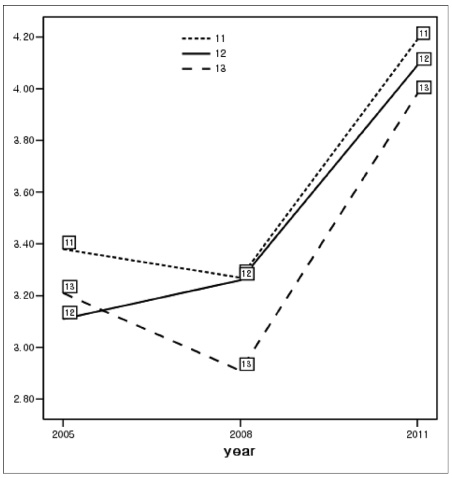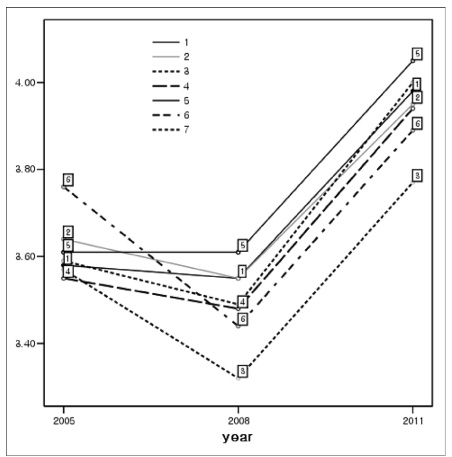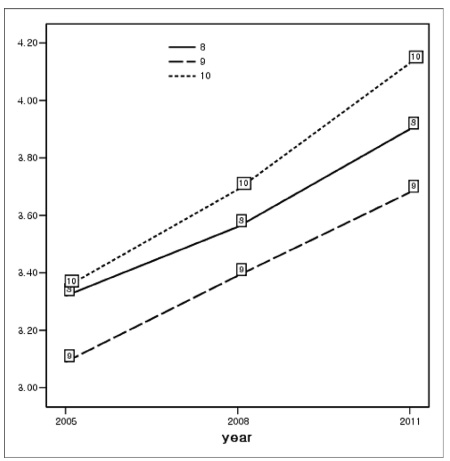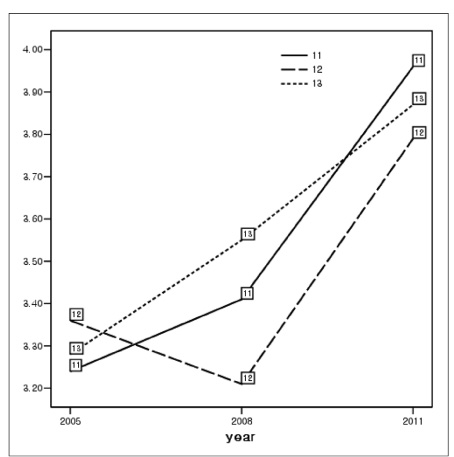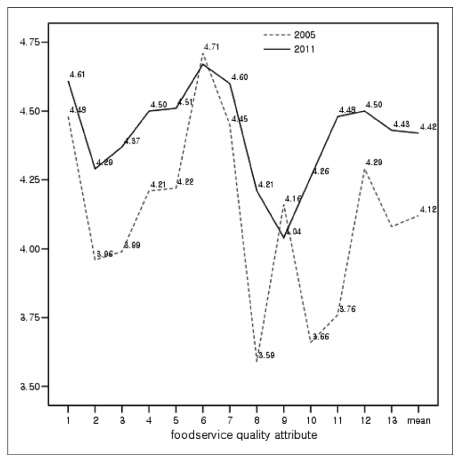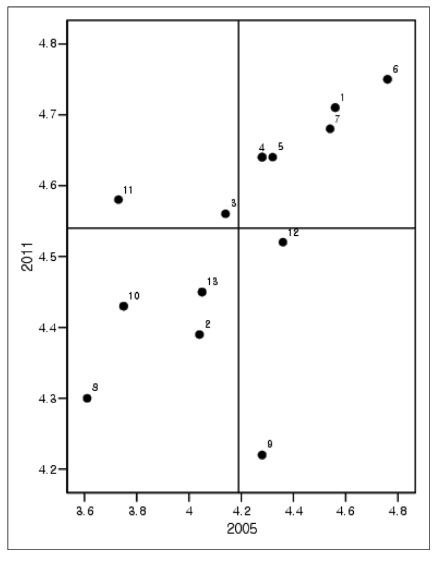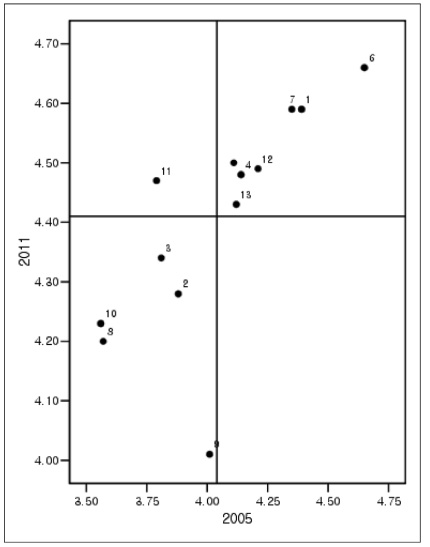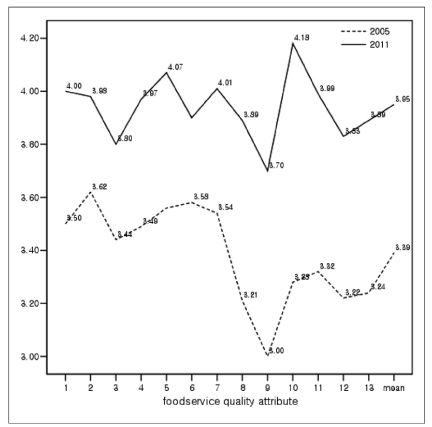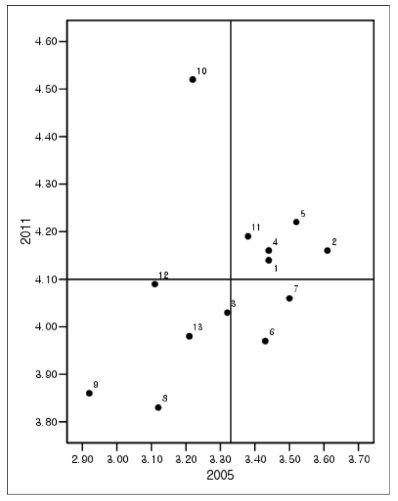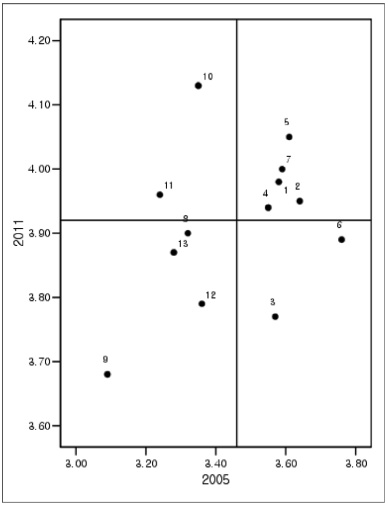Korean J Community Nutr.
2012 Aug;17(4):479-493. 10.5720/kjcn.2012.17.4.479.
Comparative Analysis of the Quality Attributes Affecting Students' Satisfaction on School Lunch Service of Middle School by Year
- Affiliations
-
- 1Department of Food & Nutrition, Hanyang Women's University, Seoul, Korea. bslee@hywoman.ac.kr
- KMID: 2267418
- DOI: http://doi.org/10.5720/kjcn.2012.17.4.479
Abstract
- This study was conducted to investigate quality attributes which could affect foodservic satisfaction by the year (2005, 2008, 2011) and dining area (classroom vs. dining hall) in order to find ways to improve school lunch service and foodservice satisfaction of middle school students. The numbers of those surveyed were 1,103 students in 2005, 1,917 students in 2008, and 1,921 students in 2011. Overall foodservice satisfaction was significantly increased gradually in dining hall food service: 3.29 +/- 1.21 in 2005, 3.45 +/- 1.00 in 2008, 3.94 +/- 0.98 in 2011. In classroom food service, overall foodservice satisfaction was not significantly different between in 2005 (3.09 +/- 0.97) and in 2008 (2.98 +/- 1.02), but it was significantly increased in 2011 (4.05 +/- 1.00). Stepwise multiple regression analysis showed that overall foodservice satisfaction was most affected by the taste of food. The importance of 11 quality attributes except food sanitation and gathering feedback on school meals was significantly increased in 2011 compared with 2005. Food sanitation among 13 attributes was most important attribute in 2005 and 2011. The numbers of quality attributes affecting students' overall foodservice satisfaction were 5 to 7 by year, those attributes were almost identical with attributes which students thought importantly. Therefore, in order to increase the overall foodservice satisfaction of the school lunch service continually, it is recommended to identify the quality attributes that are important to students, and to check their levels of performance in order to overcome their differences.
Keyword
MeSH Terms
Figure
Cited by 1 articles
-
Improving Perception and Satisfaction on Middle and High School Foodservice: The Role of Student Participation Program in Serving School Meals
Jeong-Eun Park, Kyung-Suk Choi
Korean J Community Nutr. 2018;23(3):243-256. doi: 10.5720/kjcn.2018.23.3.243.
Reference
-
1. Byun GI, Jung BH. A study on the preference and satisfaction on menu of school lunch service of high school students in Gyeonju area. Korean J Food Cult. 2006. 21(5):481–490.2. Han KS, Hong SK. A study of the operation of contract food services management and menu preferences of middle school students in Seoul. Korean J Community Nutr. 2002. 7(4):559–570.3. Jang MR, Kim JY. Comparison of importance and performance to the school lunch service according of male and female middle school students in the Gangwon province. J Korean Diet Assoc. 2005. 11(1):95–104.4. Kim KA, Kim SJ, Jung LH, Jeon ER. Degree of satisfaction on the school foodservice among the middle school students in Gwangju and Chonnam area. Korean J Soc Food Cookery Sci. 2002. 18(6):579–585.5. Kim KJ, Yi BS, Park MK. Analysis of the recognition and quality attributes on school lunch swevice of middle school students by gender in Gyeonggi province. J Korean Soc Sch Health. 2010. 23(2):297–307.6. Kim SH, Lee KA, Yu CH, Song YS, Kim WK, Yoon HR, Kim JH, Lee JS, Kim MK. Comparison of student satisfaction with the school food service programs in middle and high schools by food service management types. Korean J Nutr. 2003. 36(2):211–222.7. Kim SH, Lee KA, Yu CH, Song YS, Kim WK, Yoon HR, Kim JH, Lee JS, Kim MK. Elementary, middle and high school teachers' opinions of school foodservice programs. Korean J Nutr. 2004. 37(8):701–711.8. Kwak T, Chang H, Lee N. A Study on Cost Analyses and an Efficient Financial Management in Self-Operated and Contract-Managed Secondary School Foodservices. Korean J Nutr. 2003. 36(10):1083–1093.9. Lee HS, Jang MH. Survey of students satisfaction with school food-service programs in Gangwon province. Korean J Food Nutr. 2005. 18(3):175–191.10. Lee KE. Adolescents' Nutrient Intake Determined by Plate Waste at School Food Services. Korean J Community Nutr. 2005. 10(4):484–492.11. Lee YE. An analysis on the satisfaction with the quality of school foodservice in Chungbuk privince. Korean J Food Cult. 2008. 23(1):105–114.12. Ministry of Education & Human Resources. Comprehensive Plan for School Foodservice Improvement. 2007. 12–40.13. Ministry of Education, Science and Technology. School Meals hygiene guidelines 11-134000-000185-14. 2010. 94–99.14. Mo SJ, Suh JS, Lyu ES. The evaluation of the perception of students and employees for foodservice characteristics of in high schools in the Busan area. Korean J Food Cookery Sci. 2005. 21(2):250–262.15. Oh YM, Kim MH, Chung JS. The study of satisfaction, meal preference and improvement on school lunch program of middleschoolboys and girls in Jeonju. J Korean Diet Assoc. 2006. 12(4):358–368.16. Park MH, Choi YS, Kim YJ. Comparison of dietary attitudes and attitudes to the school lunch service of elementary and middle school students living in the same region. Korean J Community Nutr. 2002. 7(1):3–13.17. Park MK, Yang IS, Yi BS, Kim YS. Analysis of the quality attributes and the customer satisfaction in school foodservice by school type and distribution place. J Korean Diet Assoc. 2010. 16(2):83–99.18. Park YS, Lee JW, Lee MS. Comparisons of Students' and their Parents' Satisfaction of School Lunch Program in middle School by Foodservice Mangement. Korean J Community Nutr. 1997. 2(2):218–231.19. Ryu K, Woo CN, Kim WJ. Assessment of dietitian's nutritional quality management for school food service. J Korean Soc Food Sci Nutr. 2006. 35(2):238–247.20. Tenner AR, Detoro IJ. Total quality management. 1994. Addison-Wesley;89–114.21. Woodruff RB, Cadotte ER, Jenkins RL. Modeling consumer satisfaction process using experience-based norms. J Marketing Res. 1983. 20:296–304.22. Yang IS, Park MK. Identifying the Quality Attributes Affecting Customer Satisfaction of School Foodservice by City and Province: Students, Parents, and Faculty. J Korean Diet Assoc. 2008. 14(3):302–318.23. Yang IS, Yi BS, Cha JA, Han KS, Chae IS, Lee JM. Foodservice in institution. 2003. Paju: Kyomunsa;39–40.24. Yang IS, Yi BS, Park MK, Kim HY. Survey on school foodservice satisfaction(Report by grnats from of Ministry of Education, Science and Technology). 2011. Yonsei University;3–5.25. Yi BS, Yang IS, Park MK. Annual analysis on quality attributes and customer satisfaction in school foodservice. Korean J Nutr. 2009. 42(8):770–783.26. Yoo YJ, Hong WS, Chio YS. The assessment of high school students' foodservice satisfaction in accordance with type of foodservice management. Korean J Soc Food Sci. 2000. 16(2):112–120.27. Yoon JH, Choo JC, Chung SJ, Ryu SH. Satisfaction of Elementary Students Eating School Lunch; Association with Level of Involvement in School Lunch Service. Korean J Community Nutr. 2005. 10(5):668–676.
- Full Text Links
- Actions
-
Cited
- CITED
-
- Close
- Share
- Similar articles
-
- Comparison of Students' Satisfaction with Middle School Foodservice by Region in Gangwon Province
- Satisfaction of Elementary Students Eating School Lunch; Association with Level of Involvement in School Lunch Service
- Comparison of Importance and performance to the school lunch service according of male and female middle school students in the Gangwon province.
- Identifying the Quality Attributes Affecting Customer Satisfaction of School Foodservice by City and Province: Students, Parents, and Faculty
- Annual Analysis on Quality Attributes and Customer Satisfaction in School Foodservice

